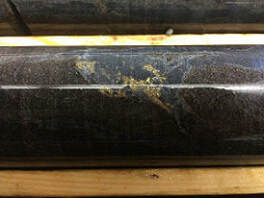Rubicon Minerals *
 Drill core from the Phoenix Gold Project - Photo courtesy of Rubicon Minerals
Drill core from the Phoenix Gold Project - Photo courtesy of Rubicon Minerals
Rubicon Minerals Phoenix Gold Project (PGP) is an underground exploration project located in the district of Red Lake, Ontario, Canada. The PGP is approximately 510 hectares in size and located approximately 16 km north of Balmertown, Ontario. The PGP consists of the high-grade ore body, named F2 Gold Deposit, more than 9,000 m of underground development including a commissioned shaft that goes down approximately 730 m below surface, and surface infrastructure that includes a 1,250 ton per day mill facility.
Currently, the PGP is in the advanced exploration, bulk mining and processing stage.There are two diamond drills that are underground drilling approximately 100 meters of core per day. The drill core is brought to surface where it is logged by professional geologists for structure and rock type. The core is then split in half - one half of the core is sent to the lab for fire assaying, while the other is stored in the core yard. The results from the assays are then used by the geologists to create a block model and a mineral resource.
The bulk sample is being mined from three different underground stopes, using development and longhole mining methods. The stopes will be mined, hoisted and stored on surface separately. This ensures that we are able to compare the tons and grade of each stope to the geologic block model to get a proper reconciliation. During the mining process, rock is sampled and sent to an assay lab to determine the grade of the stope. Each stope is then processed through the mill separately in order to compare the tons and grade to the mined and modelled tons and grade.
This process will allow Rubicon Minerals to get a better idea of what the ore body looks like and provide them with a better understanding of whether the block model matches the material being mined and processed.
For more information on Rubicon Minerals' Red Lake operations click here.
Currently, the PGP is in the advanced exploration, bulk mining and processing stage.There are two diamond drills that are underground drilling approximately 100 meters of core per day. The drill core is brought to surface where it is logged by professional geologists for structure and rock type. The core is then split in half - one half of the core is sent to the lab for fire assaying, while the other is stored in the core yard. The results from the assays are then used by the geologists to create a block model and a mineral resource.
The bulk sample is being mined from three different underground stopes, using development and longhole mining methods. The stopes will be mined, hoisted and stored on surface separately. This ensures that we are able to compare the tons and grade of each stope to the geologic block model to get a proper reconciliation. During the mining process, rock is sampled and sent to an assay lab to determine the grade of the stope. Each stope is then processed through the mill separately in order to compare the tons and grade to the mined and modelled tons and grade.
This process will allow Rubicon Minerals to get a better idea of what the ore body looks like and provide them with a better understanding of whether the block model matches the material being mined and processed.
For more information on Rubicon Minerals' Red Lake operations click here.
* Text and photographs were provided by Rubicon Minerals as part of the Beneath It All: Red Lake's Mining Story exhibit that was displayed at the Red Lake Regional Heritage Centre from July to October 2018
